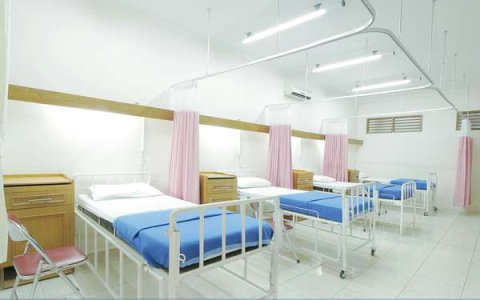Could hospitals turn you away? The looming crisis that may impact your care
- Replies 0
Picture this: you or a loved one experiences a sudden medical emergency.
You rush to the hospital, expecting immediate care—only to find the emergency room overcrowded, patients lining the hallways, and a shortage of available beds.
The doctors and nurses are overwhelmed, forced to make difficult decisions about who gets admitted and who has to wait.
A troubling new report suggests that the US healthcare system is heading toward a serious crisis—one that could prevent patients from receiving life-saving care.
With hospital systems worldwide already under strain, the ripple effects could extend beyond American borders.

The term “quad-demic” has been used to describe the intense pressure hospitals are facing this winter, as COVID-19, flu, RSV, and other respiratory illnesses fill emergency rooms.
But the real issue extends far beyond seasonal illnesses.
According to researchers, the US is on track for a severe hospital bed shortage by 2032, not because of increased hospitalizations, but due to a 16% reduction in staffed hospital beds since the pandemic.
Dr. Richard Leuchter, an assistant professor of medicine at UCLA Health and lead investigator of the study published in JAMA Network Open, warns that hospitals are already operating at dangerously high capacity.
"We’ve all heard about increased hospital occupancy during the height of the COVID-19 pandemic," Leuchter explains.
"But these findings show that hospitals are as full, if not more so, than they were during the pandemic, even well into 2024 during what would be considered a post-pandemic steady state."
Researchers analyzed hospital occupancy data from the Centers for Disease Control and Prevention (CDC) alongside the US Census Bureau projections and found that hospital occupancy rates have risen from 64% to 75% post-pandemic.
At 75% occupancy, hospitals are already struggling to accommodate surges in patient numbers.
But if no action is taken, occupancy rates could climb to 85% by 2032, which experts say could result in tens to hundreds of thousands of preventable deaths every year.
Leuchter warns, "If the US were to sustain a national hospital occupancy of 85% or greater, it is likely that we would see tens to hundreds of thousands of excess American deaths each year."
US health worker shortage. Source: Al Jazeera English / YouTube.
The problem isn’t just about more people getting sick; it’s about hospitals having fewer resources to care for patients. Several key issues are contributing to this crisis.
First, many hospitals, particularly in rural areas, have been forced to shut down due to financial struggles, leading to closures and bankruptcies.
Additionally, there are significant staffing shortages, as a lack of doctors and nurses means hospitals cannot operate at full capacity, which in turn reduces the number of available beds for patients.
Furthermore, the aging population means that more people require medical care as they grow older, further increasing the demand on already strained healthcare systems.
Experts say urgent action is required to prevent a full-blown healthcare crisis. Some possible solutions include:
Also read: Massive health coverage drop—could you be affected?

Have you or a loved one faced difficulties accessing hospital care?
What steps do you think should be taken to ensure healthcare remains available to everyone?
Share your thoughts in the comments below!
You rush to the hospital, expecting immediate care—only to find the emergency room overcrowded, patients lining the hallways, and a shortage of available beds.
The doctors and nurses are overwhelmed, forced to make difficult decisions about who gets admitted and who has to wait.
A troubling new report suggests that the US healthcare system is heading toward a serious crisis—one that could prevent patients from receiving life-saving care.
With hospital systems worldwide already under strain, the ripple effects could extend beyond American borders.

A recent report indicates that the US healthcare system is facing a potential crisis. Image source: Adhy Savala / Unsplash.
The term “quad-demic” has been used to describe the intense pressure hospitals are facing this winter, as COVID-19, flu, RSV, and other respiratory illnesses fill emergency rooms.
But the real issue extends far beyond seasonal illnesses.
According to researchers, the US is on track for a severe hospital bed shortage by 2032, not because of increased hospitalizations, but due to a 16% reduction in staffed hospital beds since the pandemic.
Dr. Richard Leuchter, an assistant professor of medicine at UCLA Health and lead investigator of the study published in JAMA Network Open, warns that hospitals are already operating at dangerously high capacity.
"We’ve all heard about increased hospital occupancy during the height of the COVID-19 pandemic," Leuchter explains.
"But these findings show that hospitals are as full, if not more so, than they were during the pandemic, even well into 2024 during what would be considered a post-pandemic steady state."
Researchers analyzed hospital occupancy data from the Centers for Disease Control and Prevention (CDC) alongside the US Census Bureau projections and found that hospital occupancy rates have risen from 64% to 75% post-pandemic.
At 75% occupancy, hospitals are already struggling to accommodate surges in patient numbers.
But if no action is taken, occupancy rates could climb to 85% by 2032, which experts say could result in tens to hundreds of thousands of preventable deaths every year.
Leuchter warns, "If the US were to sustain a national hospital occupancy of 85% or greater, it is likely that we would see tens to hundreds of thousands of excess American deaths each year."
US health worker shortage. Source: Al Jazeera English / YouTube.
The problem isn’t just about more people getting sick; it’s about hospitals having fewer resources to care for patients. Several key issues are contributing to this crisis.
First, many hospitals, particularly in rural areas, have been forced to shut down due to financial struggles, leading to closures and bankruptcies.
Additionally, there are significant staffing shortages, as a lack of doctors and nurses means hospitals cannot operate at full capacity, which in turn reduces the number of available beds for patients.
Furthermore, the aging population means that more people require medical care as they grow older, further increasing the demand on already strained healthcare systems.
Experts say urgent action is required to prevent a full-blown healthcare crisis. Some possible solutions include:
- Preventing further hospital closures and financial collapse
- Addressing staffing shortages through better wages and working conditions
- Implementing policy changes to support hospital expansion and efficiency
Also read: Massive health coverage drop—could you be affected?
Key Takeaways
- Hospitals in the US could face a severe hospital bed shortage by 2032, making critical care harder to access.
- National hospital occupancy rates have risen from 64% to 75% post-pandemic, largely due to a 16% reduction in staffed hospital beds rather than increased hospitalizations.
- If occupancy reaches 85% or higher, researchers warn it could lead to tens to hundreds of thousands of preventable deaths annually.
- Experts suggest preventing hospital closures, fixing staff shortages, and implementing policy changes to avoid a healthcare disaster.
What steps do you think should be taken to ensure healthcare remains available to everyone?
Share your thoughts in the comments below!
Last edited:






